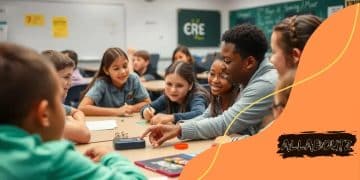Virtual reality in immersive STEM education boosts engagement

Virtual reality in immersive STEM education enhances student engagement, understanding, and retention by providing interactive and personalized learning experiences that make complex concepts more accessible.
Virtual reality in immersive STEM education has the potential to transform learning experiences in schools. Imagine students exploring the universe or conducting experiments in a virtual lab! In this article, we’ll explore how this innovative technology engages learners and boosts understanding in science and math.
What is virtual reality in education?
Virtual reality in education is a revolutionary approach that immerses students in interactive learning experiences. By using headsets, learners can step into scenarios that would be impossible to recreate in a traditional classroom. Imagine being able to explore the inside of a cell or travel to ancient civilizations without leaving your seat!
Understanding Virtual Reality
At its core, virtual reality (VR) uses technology to simulate real or imagined environments. This technology creates a digital world where users can engage with different elements in a hands-on way. Through VR, students can enhance their understanding of complex subjects by visualizing concepts that are often hard to grasp.
Benefits of Virtual Reality in Education
The use of VR in education comes with numerous advantages:
- Enhanced engagement: Students are more likely to participate when they can experience lessons actively.
- Improved retention: Immersive experiences help learners remember information better.
- Diverse learning styles: VR caters to visual, auditory, and kinesthetic learners.
For example, science classes can utilize VR to perform virtual experiments, allowing students to learn without the risks associated with real-life lab work. Moreover, when students experience a realistic simulation, they can analyze outcomes, promoting critical thinking.
Limitations to Consider
Even though virtual reality offers exciting opportunities, there are challenges. Not all schools have access to the necessary technology, and some educators may resist integrating new tools into their curriculum. Additionally, issues like motion sickness can affect user experience.
Nonetheless, as technology advances, the barriers to entry are becoming less daunting. The more we understand virtual reality‘s potential in education, the better we can prepare our students for the future.
Benefits of virtual reality for STEM learning
The benefits of virtual reality for STEM learning are transforming classrooms across the globe. This technology provides a unique way for students to engage with complex concepts in science, technology, engineering, and mathematics. They can visualize theories in a way that traditional teaching methods often cannot.
Enhanced Engagement
One of the most significant advantages of incorporating VR in STEM education is the increase in student engagement. When students immerse themselves in a virtual environment, they become participants in their learning journey. They can explore interactive simulations that make abstract concepts tangible.
Improved Understanding and Retention
Research shows that students often retain knowledge better when they can see and interact with it. In a virtual reality setting, learners can conduct experiments and manipulate variables in real-time. This hands-on experience helps them understand difficult concepts more profoundly. For instance, understanding the principles of physics through virtual experiments allows students to see how forces work in action.
- Visualize complex ideas: Students can see the inner workings of a molecule or the dynamics of planetary systems.
- Safe learning environment: VR provides a risk-free platform to experiment without real-world consequences.
- Personalized learning experiences: Each student can learn at their own pace, exploring topics that interest them most.
Moreover, virtual reality encourages collaboration among students. Through shared experiences in a VR environment, learners can work together to solve problems and reinforce each other’s understanding. This teamwork aspect mirrors real-world STEM professions where collaboration is often key to success.
Accessibility of Resources
Virtual reality also makes high-quality educational resources accessible to more students. Schools in remote areas or those with limited budgets can provide immersive learning experiences that were previously unavailable. When students can explore the ocean depths or visit Mars from their classroom, the world truly becomes their classroom, enhancing their learning possibilities.
Real-world applications of virtual reality in classrooms

Real-world applications of virtual reality in classrooms are becoming more common as educators recognize its potential to enhance learning. This innovative technology allows students to experience scenarios that wouldn’t be feasible in a traditional classroom setting, making education more dynamic and impactful.
Exploring Historical Events
One exciting application is in history classes. Students can take virtual field trips to ancient civilizations, experiencing what it was like to live in those times. For instance, they can walk through the streets of Ancient Rome or view the pyramids of Egypt up close. These immersive experiences help students connect with history by making it feel more real and relatable.
- Engagement: Students are more engaged when learning through immersive experiences.
- Deeper understanding: Experiencing historical events enhances retention of facts.
- Cultural appreciation: Students develop a better understanding of diverse cultures.
Another practical application is in science education. With VR, students can conduct virtual experiments that would be dangerous or impossible in real life. They can explore the anatomy of the human body or simulate chemical reactions safely. This kind of hands-on learning fosters curiosity and involvement, making complex subjects easier to grasp.
STEM Learning Simulations
Additionally, VR applications are prominent in teaching engineering and technology. Students can interact with 3D models of machinery or structures, allowing them to visualize and understand engineering principles effectively. By manipulating designs in virtual space, they build valuable problem-solving skills.
Moreover, virtual reality is used for environmental studies, where students can examine ecosystems, observe wildlife, and analyze environmental challenges from anywhere in the world. They can witness the impact of climate change or explore the depths of the ocean without ever leaving the classroom.
Special Education Enhancements
Virtual reality also offers remarkable benefits in the field of special education. It can create tailored environments for students with different abilities. For instance, students with autism can practice social skills in safe, controlled scenarios, helping them gain confidence in real-life interactions.
Challenges of implementing virtual reality in education
Implementing virtual reality in education comes with several challenges that schools must address. While the benefits are clear, these hurdles can slow down the integration of this innovative technology into the classroom.
Cost of Technology
One major challenge is the cost of VR technology. High-quality headsets, software, and the required hardware can be expensive for schools, especially those with limited budgets. Schools must often decide on the tools they can afford, which can mean sacrificing advanced technology.
Technical Issues
Another issue is technical difficulties. VR systems can have bugs and require regular maintenance. Teachers need adequate training to troubleshoot problems and effectively use the technology. Without this support, it can be frustrating for both educators and students.
- Need for infrastructure: Schools must have the right infrastructure, including strong internet connections, to support VR technology.
- Staff training: Educators need specific training to implement VR effectively in their lessons.
- Content availability: Finding quality VR educational content can be a challenge, limiting what teachers can use.
Furthermore, not all students can physically or mentally participate in VR experiences. Some learners may experience motion sickness or feel uncomfortable wearing headsets. This can lead to unequal learning experiences if accommodations are not made.
Curriculum Integration
Integrating VR into existing curricula is another complex task. Teachers need to find ways to align VR experiences with learning objectives, which can require significant adjustments to lesson plans. It’s essential for educators to thoughtfully consider how to incorporate VR while still meeting educational standards.
Additionally, some educators may be resistant to change. Traditional teaching methods have been successful, and convincing teachers to adopt new technologies can be a challenge. This reluctance can impact the overall effectiveness of implementing VR in classrooms.
Future trends in virtual reality and STEM education
Future trends in virtual reality and STEM education indicate exciting possibilities for enhancing learning experiences. As technology advances, we expect to see more immersive and interactive educational tools that engage students effectively.
Increased Accessibility
One key trend is the increasing accessibility of VR technology. Costs are likely to decrease as more companies enter the market, making headsets and software available for a wider range of schools. This accessibility will allow more educators to explore innovative teaching methods and integrate VR into their curriculums.
Enhanced Personalization
Another major trend is the personalization of learning experiences. With the help of artificial intelligence, VR systems can adapt content to meet individual student needs. This means learners can progress at their own pace while receiving tailored feedback, making their education more effective.
- Adaptive learning: VR can adjust to the student’s understanding, providing additional support or challenges.
- Focus on skills: VR can emphasize hands-on skills in fields like engineering, science, and technology.
- Collaborative learning: Students can work together in virtual environments, enhancing teamwork and communication.
Moreover, integration with augmented reality (AR) is on the horizon. This combination can lead to blended learning environments where students can interact with both physical and digital elements. For instance, students may be able to manipulate 3D models in real space while learning about scientific concepts.
Growing Content Libraries
The development of more comprehensive and high-quality VR content libraries is expected. With increased investment in educational VR, we can anticipate a wider array of subjects and topics becoming available. This will allow teachers to choose from a rich pool of resources to enhance their lessons.
Finally, teacher training programs will also evolve to include VR training modules. Educators will learn how to effectively integrate and utilize VR as part of their teaching strategies. This development will ensure that teachers are well-equipped to lead students through immersive learning experiences.
FAQ – Frequently Asked Questions about Virtual Reality in STEM Education
What are the main benefits of using virtual reality in STEM education?
Virtual reality enhances engagement, improves understanding, and offers students safe environments to explore complex concepts in science, technology, engineering, and math.
What challenges do schools face when implementing virtual reality technology?
Challenges include high costs, technical issues, the need for teacher training, and integrating VR effectively into existing curricula.
How can virtual reality make learning more personalized?
With AI integration, VR can tailor educational experiences to fit individual student needs, allowing them to learn at their own pace.
What future trends should we expect in virtual reality and education?
Future trends include increased accessibility, more educational content, better teacher training, and the integration of augmented reality for a blended learning experience.





